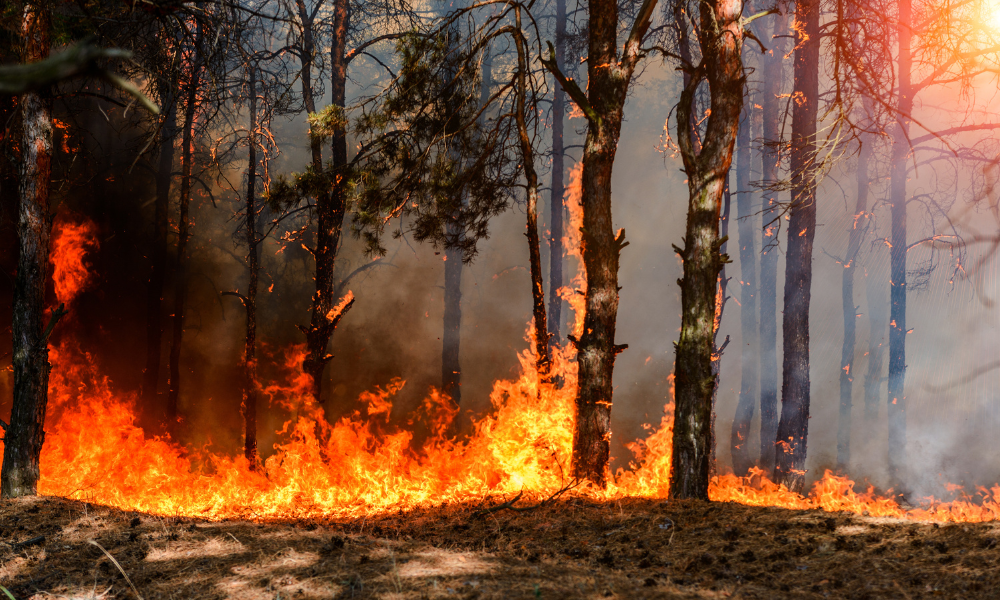How Canada can better prevent and control wildfires


This year’s wildfire season is over. In the past several years, there has been a lot of talk about forest fires or wildfires and their causes.
Forest fires are a fact of life. Forest fires have both natural and artificial causes. These are part of the natural cycle to replenish the forest. Spanish conquistadors reported forest fires in California in 1542. The trouble is you now rarely hear the term “forest fire.” Now it’s about wildfires. Wildfires are forest fires that are more intense and give rise to fire tornadoes and an effect called crowning. That is when the fire jumps across the top of the trees and can move very quickly. It seems that there are more forest fires today than there have been in the past, but that is not accurate. The severity of these wildfires is becoming much more pronounced.
By looking at wildfires and attempts to control them, we can learn a lot about the nature of risk.
In the forests, fires need fuel, and that fuel comes from a variety of sources. The primary source is trees, but also the debris that naturally accumulates on the floor of forests. Like most things, our understanding of wildfires and our approach to controlling or preventing them has evolved over the years.
Early in the 20th century, the focus was on fire prevention, suppression and extinguishing fires. In 1935, the US Forestry Service established a policy that decreed that every fire should be suppressed by 10 AM. Fire suppression and extinguishing efforts remained the focus until the early 1970s, when studies showed that it was better to let forest fires burn when possible and concentrate on forestry management.
It is foreseeable
We have seen some incredible wildfire events over the past decade or so. A wildfire entered Slave Lake Alberta in 2011. The same year, there was one of the largest fires in Canadian history north of Fort McMurray, Alberta, known as the Richardson backcountry fire. It burned over 700,000 hectares of forest and caused some of the oil sands operations to shut down. Five years later, in 2016, a wildfire destroyed whole neighbourhoods in Fort McMurray, Alberta. This year, a wildfire destroyed parts of Jasper, Alberta, one of the jewels of the Canadian Rockies.
The problem, in part, is the urban forest interface. In every case, the forest came to the residential streets of these towns uninterrupted. The results were devastating, but foreseeable.
The risk is dynamic
Over the years, a forest accumulates debris on the forest floor, which is a great fuel for forest fires. The other problem is the forests grow. A forest is just a bunch of trees. But, over time, more trees are added, and the density of trees rises. Over time, the density of the forest and the amount of debris in the forest increase. The risk increases, and it is not necessarily linear.
That is why we are talking about wildfires now instead of forest fires. Wildfires are much more intense because they have a denser fuel source in the trees and debris in the forests. Now, there are also entire stands of dead trees courtesy of the mountain pine beetle. Beetle killed trees tend to be very dry and make excellent fuel for forest fires. Whole swaths of the forest have been rendered tinder boxes by the beetle infestations.
Controls do not always work as imagined
Throughout most of the 20th century, the focus was on fire detection and suppression. This seemed a sensible approach. We all remember Smokey the Bear telling us that we have a role in preventing forest fires. Unfortunately, this suppression approach set the stage for future wildfires. Extinguishing a fire seems like a good control, but the partially burned trees create a wealth of fuel for future fires. Just because we abandoned this approach 50 years ago does not mean we are not feeling its effects now.
There are controls. Government agencies apply forestry management techniques to limit the risk and put in place systems to detect fires early and to have appropriate firefighting resources on hand. The general problem with that tends to be that a wildfire is, as the name suggests, not easy to predict and definitely not easy to control due to its sheer intensity and the speed with which it can move.
Forestry management
The primary tool to prevent wildfires and forest fires is forestry management. Forest management involves several approaches to limit the severity of fires. Since fires are expected and will occur, limiting the severity of these events is a primary concern. This includes creating fire breaks and thinning forests. Controlled burns help to reduce fuels in the forest.
There’s been a great deal of criticism about the way that Parks Canada and even the provinces have been approaching forest management. I should mention that the mayor of the town of Jasper felt that Parks Canada had done a good job in forestry management but was faced with the challenge of a long valley full of beetle killed trees.
So, good forestry management is about controlled burns, selective logging, and fire breaks. Fire breaks would be particularly important at the urban forestry interface. However, it is even possible today to go on Google Maps and see that Jasper, Alberta, has no large fire breaks around the town. The trees come right up to the town and to the residential streets.
Resources and impetus are needed to manage risk
It normally goes without saying that resources are required to manage risk. Usually, the impetus for getting those resources is demonstrating the risk, and there are usually some standards or regulations that can guide us in this.
Unfortunately, there are no requirements for forestry management. The Canadian Council of Forest Ministers published a 2016 report on the Canadian Wildland Fire Strategy. The subtitle was “A 10-year Review and Renewed Call to Action.” There is no clear agreement between the federal government and the provinces regarding forestry management, only a declaration of support. Each level of government may have very different ideas and strategies.
One has only to read the news stories around the Jasper fire this year to see the difficulties that arise when a provincial town is threatened by a wildfire inside a federal park. The 2016 report indicated there was no formal agreement established for sharing the costs of executing a $2.3 billion plan between the federal government and provincial and territorial governments.
Risk management can be political
Different governments, just as different departments in companies, can see risk in different ways. The response to wildfires and the destruction of property can vary considerably. As a survivor of the Fort McMurray wildfire in 2016, I saw an outpouring of support from across Alberta and even across Canada when the entire city had to be evacuated because of a wildfire. Even during that disaster, it was clear that there was friction between the municipal government and the provincial government. Shortly after residents were allowed to return to Fort McMurray, the forest was bulldozed back from the city to create a fire break. The next mayor of the city called for a public inquiry into the wildfire and how the response was handled. That did not get any political traction.
It is hard to imagine large, controlled burns and selective logging in national parks. That is sure to draw the ire of some.
The wildfire in Jasper, Alberta, had good some news, which was that there was no loss of life. There have been parliamentary hearings in relation to the Jasper Alberta wildfire, and there have been calls for national strategies and approaches to mitigation efforts, like the 2016 report.
Risk requires proactive assessment and control
In the face of dynamic risk, consistent and constant risk assessments are necessary. Most companies have formal risk assessments of some kind that get reviewed on a regular basis, depending on the dynamic nature of their work. Companies in manufacturing have a much less dynamic nature than companies involved in construction.
It is common when investigating an incident to encounter people who say they knew something was going to happen or they had concerns and yet remained silent or were gaslighted.
One hears the echoes of Winston Churchill. “When will the lesson be learned!”
Perhaps some prudent action is already being taken. The town of Canmore, which is located just outside Banff National Park, has announced that it intends to build a fire guard. The plan involves harvesting some trees, thinning the forest, and creating a fire guard to protect the town, as Canmore is another mountain town directly up against the forest.
There is another jewel just up the road. The town of Banff has seen some forest fires, and it is only a matter of time before a wildfire threatens the town. However, Banff is located in the federally managed Banff National Park.
The qualities of hazards change, and so does the risk.





